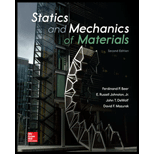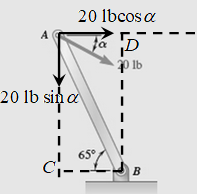
Statics and Mechanics of Materials
2nd Edition
ISBN: 9780073398167
Author: Ferdinand P. Beer, E. Russell Johnston Jr., John T. DeWolf, David Mazurek
Publisher: McGraw-Hill Education
expand_more
expand_more
format_list_bulleted
Textbook Question
Chapter 3.1, Problem 1P
A 20-lb force is applied to the control rod AB as shown. Knowing that the length of the rod is 9 in. and that

Expert Solution & Answer
Want to see the full answer?
Check out a sample textbook solution
Students have asked these similar questions
Can you provide steps and an explaination on how the height value to calculate the Pressure at point B is (-5-3.5) and the solution is 86.4kPa.
PROBLEM 3.46
The solid cylindrical rod BC of length L = 600
mm is attached to the rigid lever AB of length a
= 380 mm and to the support at C. When a 500
N force P is applied at A, design specifications
require that the displacement of A not exceed
25 mm when a 500 N force P is applied at A
For the material indicated determine the
required diameter of the rod.
Aluminium: Tall = 65 MPa, G = 27 GPa.
A
Find the equivalent mass of the rocker arm assembly with respect to the x coordinate.
k₁
mi
m2
k₁
Chapter 3 Solutions
Statics and Mechanics of Materials
Ch. 3.1 - A 20-lb force is applied to the control rod AB as...Ch. 3.1 - A 20-lb force is applied to the control rod AB as...Ch. 3.1 - A 300-N force P is applied at point A of the bell...Ch. 3.1 - A 400-N force P is applied at point A of the bell...Ch. 3.1 - A 300-N force is applied at A as shown. Determine...Ch. 3.1 - A 300-N force is applied at A as shown. Determine...Ch. 3.1 - 3.7 and 3.8 The tailgate of a car is supported by...Ch. 3.1 - 3.7 and 3.8 The tailgate of a car is supported by...Ch. 3.1 - 3.9 and 3.10 It is known that the connecting rod...Ch. 3.1 - 3.9 and 3.10 It is known that the connecting rod...
Ch. 3.1 - Rod AB is held in place by the cord AC. Knowing...Ch. 3.1 - Prob. 12PCh. 3.1 - Determine the moment about the origin O of the...Ch. 3.1 - Determine the moment about the origin O of the...Ch. 3.1 - Prob. 15PCh. 3.1 - Prob. 16PCh. 3.1 - Prob. 17PCh. 3.1 - A wooden board AB, which is used as a temporary...Ch. 3.1 - Prob. 19PCh. 3.1 - A small boat hangs from two davits, one of which...Ch. 3.1 - Prob. 21PCh. 3.1 - In Prob. 3.16, determine the perpendicular...Ch. 3.1 - In Prob. 3.16, determine the perpendicular...Ch. 3.1 - In Prob. 3.20, determine the perpendicular...Ch. 3.2 - Given the vectors P=3i-j+2k,Q=4i+5j-3k, and...Ch. 3.2 - Prob. 26PCh. 3.2 - Knowing that the tension in cable AC is 1260 N,...Ch. 3.2 - Knowing that the tension in cable AD is 405 N,...Ch. 3.2 - Three cables are used to support a container as...Ch. 3.2 - Three cables are used to support a container as...Ch. 3.2 - The 20-in. tube AB can slide along a horizontal...Ch. 3.2 - Solve Prob. 3.31 for the position corresponding to...Ch. 3.2 - Prob. 33PCh. 3.2 - Prob. 34PCh. 3.2 - Knowing that the tension in cable AB is 570 N,...Ch. 3.2 - Prob. 36PCh. 3.2 - A farmer uses cables and winch pullers B and E to...Ch. 3.2 - Solve Prob. 3.37 when the tension in cable AB is...Ch. 3.2 - To lift a heavy crate, a man uses a block and...Ch. 3.2 - Prob. 40PCh. 3.2 - Prob. 41PCh. 3.2 - Prob. 42PCh. 3.2 - Prob. 43PCh. 3.2 - A sign erected on uneven ground is guyed by cables...Ch. 3.2 - The frame ACD is hinged at and D and is supported...Ch. 3.2 - In Prob. 3.45, determine the moment about the...Ch. 3.2 - Prob. 47PCh. 3.2 - Prob. 48PCh. 3.3 - Two parallel 60-N forces are applied to a lever as...Ch. 3.3 - A plate in the shape of a parallelogram is acted...Ch. 3.3 - Prob. 51PCh. 3.3 - Prob. 52PCh. 3.3 - Four 112-in. -diameter pegs are attached to a...Ch. 3.3 - Prob. 54PCh. 3.3 - Prob. 55PCh. 3.3 - Prob. 56PCh. 3.3 - Replace the two couples shown with a single...Ch. 3.3 - Prob. 58PCh. 3.3 - Shafts A and B connect the gear box to the wheel...Ch. 3.3 - Prob. 60PCh. 3.3 - Prob. 61PCh. 3.3 - The force P has a magnitude of 250 N and is...Ch. 3.3 - Prob. 63PCh. 3.3 - A 260-lb force is applied at A to the rolled-steel...Ch. 3.3 - Prob. 65PCh. 3.3 - A force and couple act as shown on a square plate...Ch. 3.3 - Prob. 67PCh. 3.3 - Prob. 68PCh. 3.3 - Prob. 69PCh. 3.3 - Replace the 150-N force by an equivalent...Ch. 3.3 - Prob. 71PCh. 3.3 - Prob. 72PCh. 3.4 - A 4-m-long beam is subjected to a variety of...Ch. 3.4 - Prob. 74PCh. 3.4 - Determine the single equivalent force and the...Ch. 3.4 - The weights of two children sitting at ends A and...Ch. 3.4 - Prob. 77PCh. 3.4 - Prob. 78PCh. 3.4 - Four forces act on a 700375 -mm plate as shown....Ch. 3.4 - Prob. 80PCh. 3.4 - Prob. 81PCh. 3.4 - A truss supports the loading shown. Determine the...Ch. 3.4 - A machine component is subjected to the forces and...Ch. 3.4 - Solve Prob. 3.83, assuming that P=60N.Ch. 3.4 - Prob. 85PCh. 3.4 - Prob. 86PCh. 3.4 - Prob. 87PCh. 3.4 - Prob. 88PCh. 3.4 - Prob. 89PCh. 3.4 - Assuming e 600 in Prob. 3.89, replace the two...Ch. 3.4 - A blade held in a brace is used to tighten a screw...Ch. 3.4 - Prob. 92PCh. 3.4 - Four signs are mounted on a frame spanning a...Ch. 3.4 - Prob. 94PCh. 3.4 - Prob. 95PCh. 3.4 - Three children are standing on a 55-m raft. The...Ch. 3 - For the shift lever shown, determine the magnitude...Ch. 3 - Consider the volleyball net shown. Determine the...Ch. 3 - A crane is oriented so that the end of the 25-m...Ch. 3 - The 25-m crane boom AO lies in the yz plane....Ch. 3 - A single force P acts at C in a direction...Ch. 3 - While tapping a hole, a machinist applies the...Ch. 3 - A 500-N force is applied to a bent plate as shown....Ch. 3 - Prob. 104RPCh. 3 - Prob. 105RPCh. 3 - Prob. 106RPCh. 3 - Prob. 107RPCh. 3 - A regular tetrahedron has six edges of length a. A...
Additional Engineering Textbook Solutions
Find more solutions based on key concepts
Computers process data under the control of sets of instructions called
Java How to Program, Early Objects (11th Edition) (Deitel: How to Program)
The solid steel shaft AC has a diameter of 25 mm and is supported by smooth bearings at D and E. It is coupled ...
Mechanics of Materials (10th Edition)
Why is the study of database technology important?
Database Concepts (8th Edition)
Assume a telephone signal travels through a cable at two-thirds the speed of light. How long does it take the s...
Electric Circuits. (11th Edition)
What are the design issues for character string types?
Concepts Of Programming Languages
17–1C A high-speed aircraft is cruising in still air. How does the temperature of air at the nose of the aircra...
Thermodynamics: An Engineering Approach
Knowledge Booster
Learn more about
Need a deep-dive on the concept behind this application? Look no further. Learn more about this topic, mechanical-engineering and related others by exploring similar questions and additional content below.Similar questions
- 2. Figure below shows a U-tube manometer open at both ends and containing a column of liquid mercury of length l and specific weight y. Considering a small displacement x of the manometer meniscus from its equilibrium position (or datum), determine the equivalent spring constant associated with the restoring force. Datum Area, Aarrow_forward1. The consequences of a head-on collision of two automobiles can be studied by considering the impact of the automobile on a barrier, as shown in figure below. Construct a mathematical model (i.e., draw the diagram) by considering the masses of the automobile body, engine, transmission, and suspension and the elasticity of the bumpers, radiator, sheet metal body, driveline, and engine mounts.arrow_forward3.) 15.40 – Collar B moves up at constant velocity vB = 1.5 m/s. Rod AB has length = 1.2 m. The incline is at angle = 25°. Compute an expression for the angular velocity of rod AB, ė and the velocity of end A of the rod (✓✓) as a function of v₂,1,0,0. Then compute numerical answers for ȧ & y_ with 0 = 50°.arrow_forward
- 2.) 15.12 The assembly shown consists of the straight rod ABC which passes through and is welded to the grectangular plate DEFH. The assembly rotates about the axis AC with a constant angular velocity of 9 rad/s. Knowing that the motion when viewed from C is counterclockwise, determine the velocity and acceleration of corner F.arrow_forward500 Q3: The attachment shown in Fig.3 is made of 1040 HR. The static force is 30 kN. Specify the weldment (give the pattern, electrode number, type of weld, length of weld, and leg size). Fig. 3 All dimension in mm 30 kN 100 (10 Marks)arrow_forward(read image) (answer given)arrow_forward
- A cylinder and a disk are used as pulleys, as shown in the figure. Using the data given in the figure, if a body of mass m = 3 kg is released from rest after falling a height h 1.5 m, find: a) The velocity of the body. b) The angular velocity of the disk. c) The number of revolutions the cylinder has made. T₁ F Rd = 0.2 m md = 2 kg T T₂1 Rc = 0.4 m mc = 5 kg ☐ m = 3 kgarrow_forward(read image) (answer given)arrow_forward11-5. Compute all the dimensional changes for the steel bar when subjected to the loads shown. The proportional limit of the steel is 230 MPa. 265 kN 100 mm 600 kN 25 mm thickness X Z 600 kN 450 mm E=207×103 MPa; μ= 0.25 265 kNarrow_forward
- T₁ F Rd = 0.2 m md = 2 kg T₂ Tz1 Rc = 0.4 m mc = 5 kg m = 3 kgarrow_forward2. Find a basis of solutions by the Frobenius method. Try to identify the series as expansions of known functions. (x + 2)²y" + (x + 2)y' - y = 0 ; Hint: Let: z = x+2arrow_forward1. Find a power series solution in powers of x. y" - y' + x²y = 0arrow_forward
arrow_back_ios
SEE MORE QUESTIONS
arrow_forward_ios
Recommended textbooks for you
 International Edition---engineering Mechanics: St...Mechanical EngineeringISBN:9781305501607Author:Andrew Pytel And Jaan KiusalaasPublisher:CENGAGE L
International Edition---engineering Mechanics: St...Mechanical EngineeringISBN:9781305501607Author:Andrew Pytel And Jaan KiusalaasPublisher:CENGAGE L

International Edition---engineering Mechanics: St...
Mechanical Engineering
ISBN:9781305501607
Author:Andrew Pytel And Jaan Kiusalaas
Publisher:CENGAGE L
How to balance a see saw using moments example problem; Author: Engineer4Free;https://www.youtube.com/watch?v=d7tX37j-iHU;License: Standard Youtube License